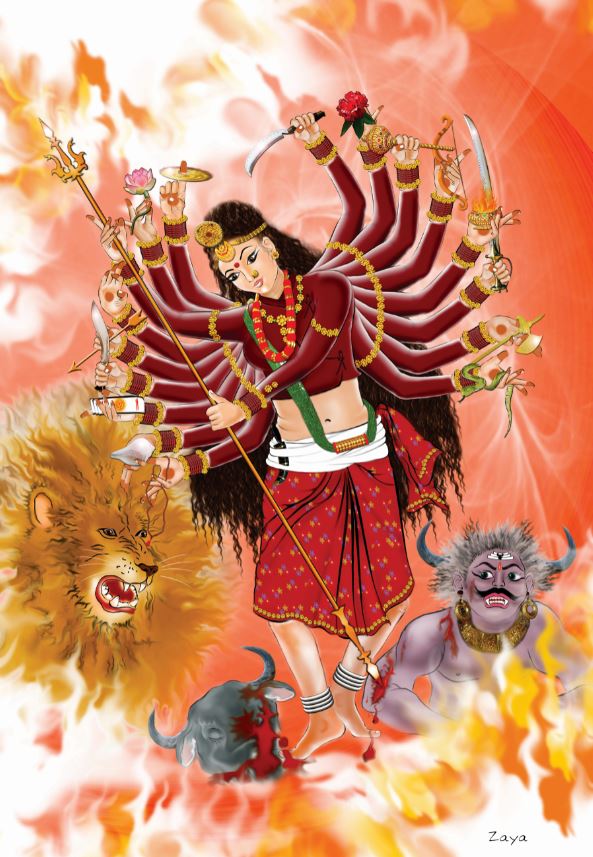When she started painting on a computer back in 2002, Jaya Sharma did not even know what she was doing was called. She had taken up ‘digital painting’ only because she was depressed. In 2009 Sharma would go on to be the first Nepali artist to put up a solo exhibit of digital paintings.
Always interested in painting, Sharma had been enrolled for Bachelor’s in Fine Arts degree at Lalitkala Campus. Right before her final exam in 1999, the famous journalist and director Subrat Acharya asked her hand in marriage. “I still remember we had our engagement on the day of my final exam,” she says.
Her final exam was from 1 pm to 4 pm. But her engagement was then scheduled for 2 pm. She decided to give her exam next year. But when she approached her professor Seema Shah with the problem, the teacher said that she could take the exam at 10 am and then get engaged on the same day. “As a woman, you have to find a balance between your family and career,” said Shah, something that has stuck with Sharma all these years.
Sharma’s life changed after she got married. “People say artists think freely. But I don’t think that is necessarily true. Whenever I tried spreading my wings, I felt like there was no space,” says Sharma.
When she moved into her in-laws’ place, she found no proper place where she could mix her colors and paint. “Even though I could not paint anymore, I treasured my color boxes. But when I looked through them, I found that all the colors had been thrown away and replaced with stitching materials,” she recalls. Sharma started slipping into depression.
Her husband who worked in the entertainment industry would be home only from 1 am to 6 am. She did not want to bother his busy hubby with what she was going through. But when she went into a depression, he realized that he needed to give her more time.
They had a son in 2001, and by 2002 Sharma had decided to turn her life around.
She remembered being captivated by the “Paint” icon on computer painting tools. If she could not paint on real canvas, couldn’t she do so on a digital one? But for that Sharma first needed her own computer, and she did not want to ask anyone for money. She sold her jewelry. A tola of gold at the time cost Rs 15,000, and she sold some Rs 100,000 worth of it. “Till now, whenever the price of gold goes up, my family members scold me for selling that gold,” says Sharma. But she has no regrets.
With the help of her new computer, she first started making greeting cards and turning photos into artwork. Six years after that, one day, her friend Kapil Mani Dixit saw her works and informed her that what she had been doing all these years was called digital painting. He liked her works so much he wanted to showcase them during the 2009 opening of his art studio ‘Apt #8’. There has since been no turning back for Sharma.
Her husband then encouraged her to try making album covers. Her first commissioned work was an album cover for Narad Khatiwada’s ‘Bidhyanaas’. Then she started getting work from others. She designed a cover for MaHa jodi’s “Dashain” and also a comic book for WWF. “But I soon realized I did not want to work on other’s ideas. I wanted to create a fantasy world of my own,” Sharma says.
She is now a surrealist painter, “who follows dreams and gets inspired by real objects to create a fantasy world.” Till date she has had two solo and nine group exhibitions of her digital artwork and a total of 53 exhibitions altogether.
Sharma went back to Lalitkala Campus in 2017 to finish her Master’s degree. She was excited to study with younger people as she could learn from the new generation. But things didn’t go as planned, and she was disappointed to realize that “most people now do not search for inspiration within themselves but more on Google.” She got into fights over copyright with her classmates who copied other artists.
She says it is easy to cheat and copy other’s works in this digital age: “But if you are dishonest with your work, you will have to pay for it sooner or later.”
Currently busy preparing for exhibitions in India, Sharma accepts that she has come a long way. “But that doesn’t mean you stop learning.”













